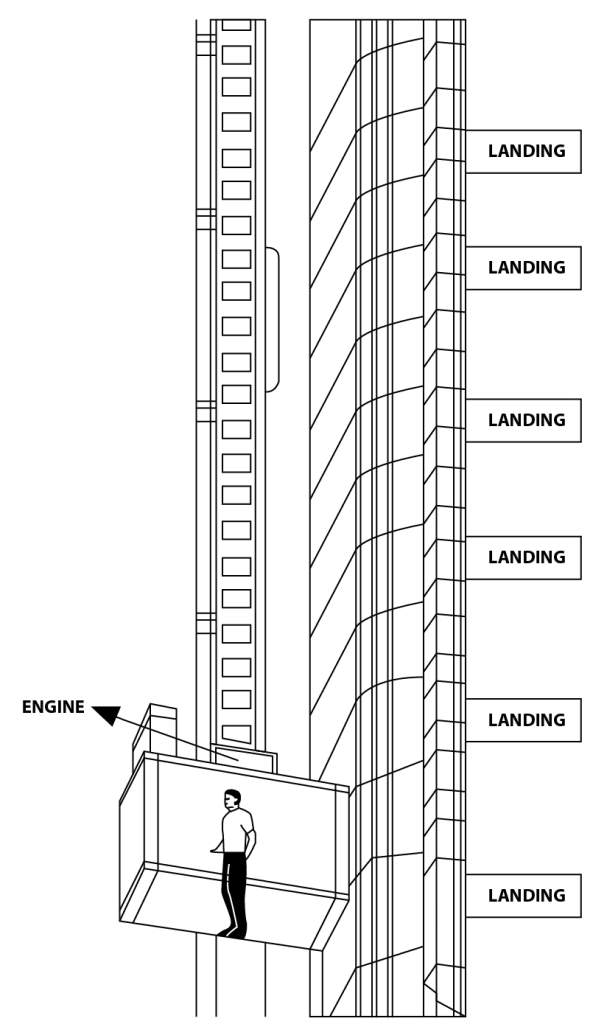Although there are several types and models of elevators, not all can serve the same purpose. Unlike other machines, a climbing system is not designed for passenger movement in residential and commercial buildings, instead, high-rise building and construction sites like, towers. Another key feature of climbing elevators is that they are self-powered, which means they ascend on their own. Climbing elevators operate on combustion engines or electricity.
The latest demands in skyscrapers have driven the need for climbing elevators in the construction industry to another level. Today, it is one of the basic machines for construction workers.

How Climbing Elevators Operate
This type of hoist system relies on permanent entrances, cars, controllers and other basic features to facilitate the movement of workers at construction sites, their tools and simple building materials. The system uses the hoist ways of the building as the work progresses. Due to their mobile machine room, each hoist way is divided into two to give room for the placement of rails and other components. Since the system assumes the form of work being conducted on the building, there is also greater chance for customization at every stage.
The self-propulsion feature of climbing elevators, they can be used in all kinds of weather including, rain, wind or sunshine. In fact, the lifts can still operate efficiently regardless of even the external structure of the building. A climbing elevator can be customized to complement the profile of a particular building under construction as the work continues. For example, the system’s mobile machine room is moved up based on the number of floors. The elevator is installed within and also as part of the permanent structure of the building.
A climbing machine is also quite fast and reliable when it comes to propulsion. As a result of this, it is a great option that can significantly enhance productivity and quality of services at less cost. The machine can cut down the time spent on building and construction by about 20 percent for better returns on investment. In most occasions, workers are able to complete projects much earlier than the expected deadlines, thanks to the climbing system.
When the construction work is completed, it is much easier to switch to a permanent elevator. You will only need to install the machine room, control features and conduct surface finishing for the lift car and other elements like doors.
Benefits of a Climbing System
Implementing a climbing elevator in construction procedures offers great advantages not only to the workers but also investors or building owners. Some of those you will be able to experience with one include;
Reduced wait time
Despite the modifications that can be done on climbing elevators, they usually operate at high speeds of up to 4 meters per second. This is almost five times faster than conventional machines used in construction sites. Since the system can facilitate faster movement of workers and building materials, they are ideal for saving time. With the system, workers will spend little time standing in wait or performing their tasks. Besides, a climbing lift can also accommodate many people at a time, construction engineers will only need a few external hoists, which helps in cost reduction.
Efficiency in construction
In most occasions, many investors are forced to wait until all the finer details of an entire building are finished to start using it. Considering that the permanent hoist way for construction is the one that supports the operations of the elevator, completed levels of the property can be put to use as the installation continues in the ones above. Since the machine can be easily customized to a building’s structure, there is also an assurance that the work will not come to a halt regardless of the height.
Safety
The safety of an elevator is one of the main concerns of both manufacturers and construction workers. Climbing elevators are designed with a shaft within which the construction workers are transported across the building. This enables workers to use the machine in all weather conditions, thereby eliminating a number of hindrances to construction projects. Coupled with the innovative safety measures included in the system, it can effectively prevent a number of accidents that could harm workers and impact the construction process.
Convenience
It usually occurs in some urban areas that whenever a high rise building is under construction, nearby streets and side-walks remain closed. As much as this offers workers an ample time to focus on their activities, it can also be very inconveniencing to the community or people using those streets. Climbing lifts require less external hoists, which can help in ensuring traffic around the site is not hindered during the construction process.
Reduced Construction and operational costs
Constructing buildings is a process that usually comes at a higher financial cost, and every investor always desires a better way of cutting down expenses. The ability of the system to move workers across various levels at faster speeds can enable them complete the project in less time, thereby reducing the overall costs for not only the construction firms but building owners as well.
Climbing elevators are also very friendly to the environment. But, it is always advisable to frequently check the system before being put to use just to be sure that it does not pose any threats to workers and the community in the environment. Through this process, you will be able to determine any area that requires maintenance.
